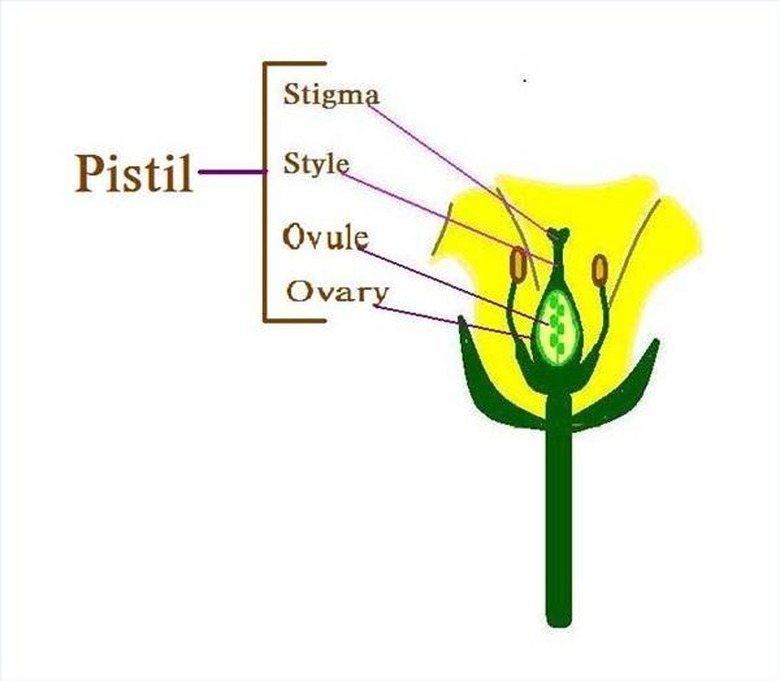Female Parts Of A Flower
While some flowers have independent male and female parts, most flowers contain both. The female part of the plant is known as the pistil. The pistil is made up of four parts: the stigma, style, ovary and ovules. In order to reproduce, flowering plants produce pollen which is then transferred to the female part of the plant through the process of pollination.
The Pistil: The Female Part of a Plant
The Pistil: The Female Part of a Plant
The pistil is the female part of the plant where pollination occurs. Pollination is when the pollen, which contains the male reproductive cells, mixes with the female reproductive cells to create embryos for reproduction. Once fertilization takes place, seeds are formed. The embryos contained in the seeds disperse to grow into new plants. Each of the four parts of the pistil have an important role to play in the process of pollination and development of the plant embryo.
The Process of Pollination
The Process of Pollination
Pollination is the process in which the pollen is transferred from the male stamen to the female stigma. Different plants have different methods for pollination. Many plants have beautiful flowers that attract and coerce different animals into unknowingly being pollination vectors. Some plants rely on the wind to carry their pollen from one flower to another, like conifers from the Pinophyta order. Though rare, some plants like turtle grass (Thalassia testudinum) use water to float their pollen to the stigma of another flower in a process known as hydrophily.
Some plants can also self-pollinate; this means that their male and female gametes successfully mix during fertilization to produce embryos. However, most plants need to cross-pollinate, which is when a plant needs the pollen from a different plant of the same species for successful fertilization. Cross-pollination results in higher genetic diversity, which ultimately increases the chances of survival.
The benefit of self-pollination is that plants can create new offspring when pollen from other plants is hard to find. Despite this benefit, some plants, like the New Zealand flax (Phormium tenax), actively avoid self-pollination. These plants use various methods, including having their anthers, which hold the pollen, develop at a different time than their stigmas.
Parts of the Pistil: Stigma
Parts of the Pistil: Stigma
In the pollination process, the stigma is the female part of the plant designed for catching pollen. The stigma has a sticky surface to help catch the pollen. Once pollen lands on the stigma, it begins to germinate. The germination process results in pollen tubes forming and traveling down the style.
Parts of the Pistil: Style
Parts of the Pistil: Style
The style is a long filament that connects the stigma to the ovules inside the ovary at the flower base. Styles will vary in length and size from flower to flower. This is because the anatomy of a flower will vary depending on the vector of pollination it is designed for. For example, wind-pollinated flowers tend to have long styles to help the stigma catch pollen in the wind. On the other hand, animal and insect-pollinated flowers may have shorter styles as the flower is designed to draw the animal close enough to collect and deliver pollen.
Parts of the Pistil: Ovules
Parts of the Pistil: Ovules
The ovules contain the female reproductive gametes and nutrients for embryo development. Once the pollen tubes reach the ovules, fertilization occurs. The fertilized ovules develop to form seeds. Inside the seeds are plant embryos that will later grow into a new plant when the conditions are right.
Parts of the Pistil: Ovary
Parts of the Pistil: Ovary
The ovary is located at the base of the pistil. This is the fleshy area that holds the ovules. As the embryos in the seeds develop, the ovary swells to produce fruit. The fruit helps protect the developing embryos. Plants that use animals to disperse their seeds evolved fruit that is a delicious food source for birds and mammals. Once the seeds are ready for dispersal, the fruit becomes juicy and sweet and often changes from green to red, orange or purple to entice hungry animals.
There are a lot of different flower ovary designs that form fruit. For example, perigynous flowers only have one ovule in their ovary, which forms fruit like peaches (Prunus spp.) or avocados (Persea americana). In other fruit, like tomatoes (Solanum lycopersicum), the ovary contains multiple ovules. Some fruit are called inflorescences, like pineapples (Ananas comosus), and these are made up of many flowers, each with several fertilized ovaries. In aggregate fruit, like raspberries (Rubus idaeus), there are technically many individual ripened ovaries, each with one ovule, all bunched together.
References
Cite This Article
MLA
Jerrett, Adrianne. "Female Parts Of A Flower" sciencing.com, https://www.sciencing.com/female-parts-of-a-flower-13426265/. 30 September 2021.
APA
Jerrett, Adrianne. (2021, September 30). Female Parts Of A Flower. sciencing.com. Retrieved from https://www.sciencing.com/female-parts-of-a-flower-13426265/
Chicago
Jerrett, Adrianne. Female Parts Of A Flower last modified March 24, 2022. https://www.sciencing.com/female-parts-of-a-flower-13426265/
